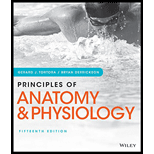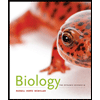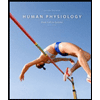
Principles of Anatomy and Physiology
15th Edition
ISBN: 9781119329398
Author: Gerard J Tortora, Bryan Derrickson
Publisher: John Wiley & Sons Inc
expand_more
expand_more
format_list_bulleted
Concept explainers
Textbook Question
Chapter 16, Problem 3CTQ
Marvin has had trouble sleeping. Last night his mother found him sleepwalking and gently led him back to his bed. When Marvin was awakened by his alarm clock the next day. he had no recollection of sleepwalking and, in fact, told his mother about the vivid dreams he had. What specific stages of sleep did Marvin undergo during the night? What neurological mechanism awakened Marvin in the morning?
Expert Solution & Answer
Want to see the full answer?
Check out a sample textbook solution
Students have asked these similar questions
Marvin has had trouble sleeping. Last night his mother found him sleepwalking and gently led him back to his bed. When Marvin was awakened by his alarm clock the next day, he had no recollection of sleepwalking and, in fact, told his mother about the vivid dreams he had. What specific stages of sleep did Marvin undergo during the night? What neurological mechanism awakened Marvin in the morning?
Functions of basal ganglia include all the following, except :-a- planning and programming of voluntary movementsb- initiation of reflex movement.c- postural regulationd- executing learned pattern of movement.
why is sleep so important? How does the lack of sleep affect the brain negatively?
Chapter 16 Solutions
Principles of Anatomy and Physiology
Ch. 16 - How is sensation different from perception?Ch. 16 - 2. What is a sensory modality?
Ch. 16 - What is a receptor potential?Ch. 16 - What is the difference between rapidly adapting...Ch. 16 - Prob. 5CPCh. 16 - Prob. 6CPCh. 16 - Which somatic sensory receptors mediate touch...Ch. 16 - How does fast pain differ from slow pain?Ch. 16 - Prob. 9CPCh. 16 - 10. What aspects of muscle function are monitored...
Ch. 16 - What are the functional differences between the...Ch. 16 - Prob. 12CPCh. 16 - 13. What type of sensory information is carried in...Ch. 16 - Prob. 14CPCh. 16 - 15. Which parts of the body have the largest...Ch. 16 - Prob. 16CPCh. 16 - 17. Explain the role of the cerebral cortex, basal...Ch. 16 - Describe how sleep and wakefulness are related to...Ch. 16 - What are the four stages of non-rapid eye movement...Ch. 16 - Define memory. What are the three kinds of memory?...Ch. 16 - What is long-term potentiation?Ch. 16 - What is language?Ch. 16 - Prob. 1CTQCh. 16 - 2. Monique sticks her left hand into a hot tub...Ch. 16 - 3. Marvin has had trouble sleeping. Last night his...
Additional Science Textbook Solutions
Find more solutions based on key concepts
Jellyfish Lake, located on the Pacific island of Palau, is home to millions of jellyfish. Many years ago, sea l...
BIOLOGY:THE ESSENTIALS (LL) W/CONNECT
Gregor Mendel never saw a gene, yet he concluded that some inherited factors were responsible for the patterns ...
Campbell Essential Biology (6th Edition) - standalone book
Propose a model for the assembly of a flagellum in a typical Gram-positive cell envelope.
Prescott's Microbiology
Why are mutants used as test organisms in the Ames test?
Laboratory Experiments in Microbiology (11th Edition)
Which of the following would be used to identify an unknown bacterial culture that came from a patient in the i...
Microbiology Fundamentals: A Clinical Approach
Knowledge Booster
Learn more about
Need a deep-dive on the concept behind this application? Look no further. Learn more about this topic, biology and related others by exploring similar questions and additional content below.Similar questions
- Julio D., who had recently retired, was enjoying an afternoon of playing golf when suddenly he experienced a severe headache and dizziness. These symptoms were quickly followed by numbness and partial paralysis on the tipper right side of his body, accompanied by an inability to speak. After being rushed to the emergency room, Julio was diagnosed as having suffered a stroke. Given the observed neurological impairment, what areas of his brain were affected?arrow_forwardDuring a robbery at his convenience store, Dustin was shot in the right cerebral hemisphere. He survived, although some specific functions were impaired. Would Dustin have been more likely or less likely to have survived if he had been shot in the medulla oblongata? Why?arrow_forwardPhineas Gage was a 19th century railroad worker who survived an accident that drove a large iron rod through his head. If the injury resulted in him becoming temperamental and capricious what part of his brain was damaged? a. frontal lobe b. hippocampus c. parietal lobe d. temporal lobearrow_forward
- Which two states of consciousness are between alertness and coma?arrow_forwardThe outer surface of the brain contains numerous valleys and ridges. What are the valleys called? What are the ridges called?arrow_forwardYou are walking to class, pondering the intricacies of physiology, when you trip over an uneven place in the sidewalk and fall. Unhurt but embarrassed and angry, you jump up and glance around to see if anyone is watching. From your knowledge of neuroanatomy and function, explain how the following areas of the brain might be involved in this scenario: cerebrum cerebellum limbic systemarrow_forward
- Briefly describe each stage of sleep, including REM. 2. Mention the main events of each stage clearly and in order. Include: alpha, theta, sleep spindles, K-complex, delta waves. 3.Mention one thing you do to get a good night sleep. (300 words max)arrow_forwardWhat are sleep’s functions?arrow_forwardWhich of these statements about the basal nuclei is true?a. They are located in the cerebrum.b. They contain the caudate nucleus.c. They are involved in motor control.d. They are part of the extrapyramidal system.e. All of these are true.arrow_forward
- Peyton felt strange when she awoke one morning. She could not hold a pen in her right hand when trying to write an entry in her diary, and her muscles were noticeably weaker on the right side of her body. Additionally, her husband noticed that she was slurring her speech, so he took her to the emergency room. What does the ER physician suspect has occurred? Where in the brain might the physician suspect that abnormal activity or perhaps a lesion is located, and why?arrow_forwardThe cerebral cortex of each cerebral hemisphere is divided into which four lobes?arrow_forward
arrow_back_ios
arrow_forward_ios
Recommended textbooks for you
 Biology: The Dynamic Science (MindTap Course List)BiologyISBN:9781305389892Author:Peter J. Russell, Paul E. Hertz, Beverly McMillanPublisher:Cengage Learning
Biology: The Dynamic Science (MindTap Course List)BiologyISBN:9781305389892Author:Peter J. Russell, Paul E. Hertz, Beverly McMillanPublisher:Cengage Learning Human Physiology: From Cells to Systems (MindTap ...BiologyISBN:9781285866932Author:Lauralee SherwoodPublisher:Cengage Learning
Human Physiology: From Cells to Systems (MindTap ...BiologyISBN:9781285866932Author:Lauralee SherwoodPublisher:Cengage Learning

Biology: The Dynamic Science (MindTap Course List)
Biology
ISBN:9781305389892
Author:Peter J. Russell, Paul E. Hertz, Beverly McMillan
Publisher:Cengage Learning

Human Physiology: From Cells to Systems (MindTap ...
Biology
ISBN:9781285866932
Author:Lauralee Sherwood
Publisher:Cengage Learning


Animal Communication | Ecology & Environment | Biology | FuseSchool; Author: FuseSchool - Global Education;https://www.youtube.com/watch?v=LsMbn3b1Bis;License: Standard Youtube License